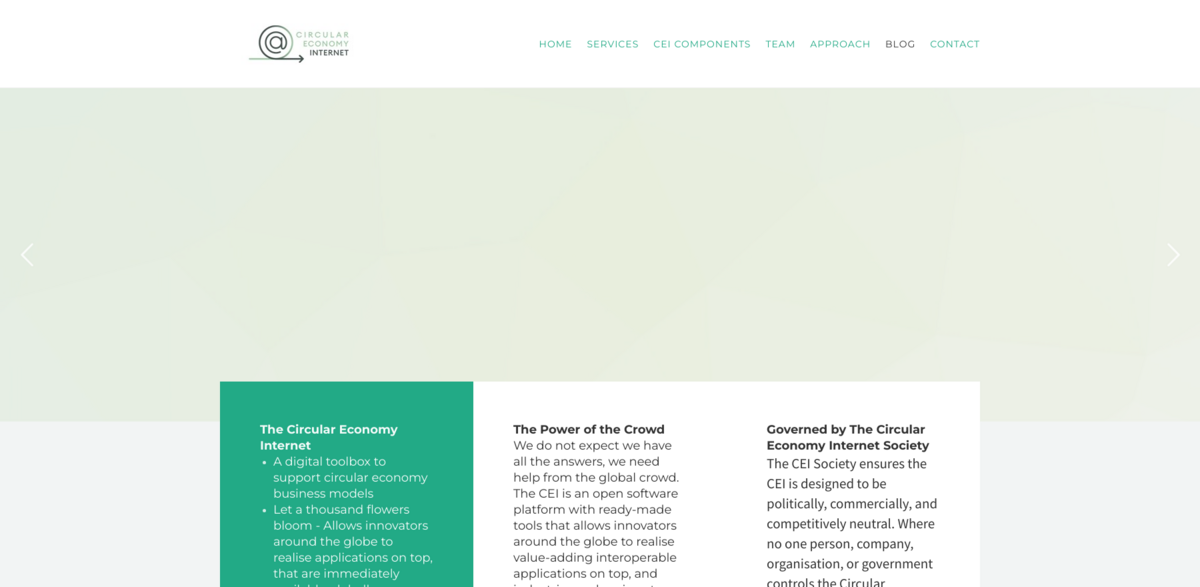What is the Circular Economy Internet Project?
The Circular Economy Internet (CEI) is an open software platform designed to exponentially accelerate circularity. Digitisation is fundamental in realizing the circular economy – and CEI is arguably the most impactful activity toward a global circular economy. This project is set to become the digital backbone of the circular economy, serving as a comprehensive toolbox that supports circular business models. CEI reduces adoption barriers, cost, risk, and time, enabling small and medium-sized enterprises along with emerging markets to participate efficiently. By linking initiatives across sectors, the platform is built on many-to-many interoperability – making digital integration across value chains not just possible but seamless… It’s a transformative solution in a world that increasingly demands less waste and lower emissions.
Main Benefits
Key facts and figures illustrate the core benefits:
- Reduction of adoption barriers, cost, risk, and time.
- Accelerated realization of circular economy solutions, turning more circular business models commercially and environmentally viable.
- A vision where “a 1.5° world can only be a circular world,” driving a global transformation toward less waste and lower emissions.
- The promise of creating 700,000 new jobs, while decreasing the need for 1.7 planets by 2030.
Open Platform and Digital Toolbox
CEI delivers a digital toolbox designed to support circular economy business models. It offers ready-made tools and interoperable applications, so innovators around the globe can quickly develop solutions that fit specific regional or industrial needs. As the phrase goes – “let a thousand flowers bloom!” – the platform allows numerous value-adding applications to be built on top of it, thereby expanding its commercial potential while ensuring rapid global scalability. With its components closely mirroring those of today’s ERP systems or supply chain management software, CEI’s design is built to support complex ecosystems and multiple value chains without the headache of one-to-one integration.
Innovation through the Crowd
One of the most exciting aspects of the Circular Economy Internet is the power of the crowd. The platform does not claim to have all the answers – instead, it invites global participation. It is an open software platform that welcomes innovators to contribute, leading to the creation of interoperable applications that provide value beyond individual systems. The approach, which may seem casual at first glance, emphasizes that innovation thrives through collaboration and shared insights… This open dynamic encourages creative solutions and local adaptations on a global scale.
Governance as a Global Public Good
Governance of the Circular Economy Internet is entrusted to the CEI Society. The society ensures that the platform remains politically, commercially, and competitively neutral, guarding against control by any single person, company, organisation, or government. The CEI is thus positioned as a shared global public good, with a governance model that establishes shared principles, norms, rules, and decision-making procedures. This transparent and inclusive structure ensures that the evolution of the CEI is balanced and is built in the interests of the collective progress towards a global circular economy.
Project Impact
- SDG 9: Industry, Innovation and Infrastructure – Supporting digital backbones for efficient circular systems.
- SDG 11: Sustainable Cities and Communities – Creating digital solutions that contribute to more sustainable urban environments.
- SDG 12: Responsible Consumption and Production – Promoting business models that extend the life of resources.
- SDG 13: Climate Action – Accelerating the transition to low-emission economies.
- SDG 17: Partnerships for the Goals – Fostering global collaboration and interoperability among diverse stakeholders.
Future Trends and Development
Looking ahead, the Circular Economy Internet is poised to be much more than just a collection of software tools; it is a dynamic platform that will adapt and evolve with the needs of the global community. Its digital components – from Part Tracking (PT) to the Financial Flow (FF) and Application Registry (AR) – form a comprehensive ecosystem that supports every aspect of the circular economy. These components include solutions for urban mining, hazardous packing management, digital cradle-to-cradle passports, and much more. The platform’s design ensures that innovations can be integrated quickly and that the commercial potential is immediately available around the globe. In a world where digital solutions often complicate integration, CEI simplifies the process so that different sectors can operate efficiently and collaboratively. The open and inclusive nature of the platform promises new possibilities and flexible adaptation to the rapidly changing digital landscape, making it an exciting development in the global transition towards a sustainable, circular future.





















